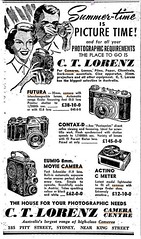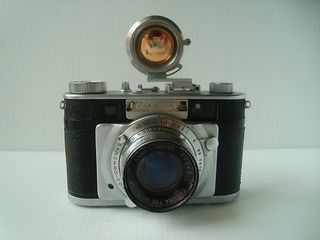Difference between revisions of "Futura"
m (→History) |
m (Minor changes) |
||
| Line 10: | Line 10: | ||
}} | }} | ||
| − | '''Fritz Kuhnert, Optische Anstalt''', an optics factory, had been producing optical equipment for the German Luftwaffe<ref>In 1944 his workforce comprised of 142 men and 91 women of which 41 (39 men and 2 women were forced labour from various parts of Europe | + | '''Fritz Kuhnert, Optische Anstalt''', an optics factory, had been producing optical equipment for the German Luftwaffe<ref>In 1944 his workforce comprised of 142 men and 91 women of which 41 (39 men and 2 women) were forced labour from various parts of Europe. Source: Bernd Spitzmüller (2004) ''Aber das Leben war unvorstellbar schwer. Die Geschichte der Zwangsarbeiter und Zwangsarbeiterinnen in Freiburg während des Zweiten Weltkriegs'' . Freiburg : Stadtarchiv Freiburg im Breisgau. P. 106.—The factory was destroyed in the Allied massed bomber attack on Freiburg 27 November 1944.</ref> in the Lehener Straße of Freiburg/Breisgau, and had been destroyed in WWII. |
After the war its founder Fritz Kuhnert built a new factory nearby in Gundelfingen. In 1947 he introduced the Efka 24, a viewfinder camera for 24×24mm frame format. The Futura rangefinder camera became his flagship product, introduced at the first [[Photokina]] in 1950. | After the war its founder Fritz Kuhnert built a new factory nearby in Gundelfingen. In 1947 he introduced the Efka 24, a viewfinder camera for 24×24mm frame format. The Futura rangefinder camera became his flagship product, introduced at the first [[Photokina]] in 1950. | ||
| Line 18: | Line 18: | ||
Later production (specifically the [[Futura S]]) had a modified, functional, light baffle between the flange and the shutter leaves, which serves to allow the 50mm to couple with and drive the longer lenses (see esp. the [[Futura Tele-Elor 5.6/90]]). | Later production (specifically the [[Futura S]]) had a modified, functional, light baffle between the flange and the shutter leaves, which serves to allow the 50mm to couple with and drive the longer lenses (see esp. the [[Futura Tele-Elor 5.6/90]]). | ||
| − | The camera system offered two of the fastest lenses of its time, a [[standard lens]] and a [[portrait lens]], both of the f | + | The camera system offered two of the fastest lenses of its time, a [[standard lens]] and a [[portrait lens]], both of the f/1.5 lens construction named [[Futura Frilon]]. |
| − | In 1958 Futura stopped its production. | + | In 1958 Futura stopped its production. Most Futura cameras were produced for export. |
== Cameras == | == Cameras == | ||
| Line 41: | Line 41: | ||
== Lenses == | == Lenses == | ||
| − | + | Lens calculations were done by lens maker [[Schneider]]'s optician Werner Giesbrecht for Futura. All lenses except Schneider's original [[Xenar]] were of Futura's own production. The lenses were named like Kuhnert's family members: Elor like his wife Eleonore, Evar und Petar like his children Eva und Peter. | |
| − | Lens calculations were done by lens maker [[Schneider]]'s optician Werner Giesbrecht for Futura. All lenses except Schneider's | ||
*Futura Ampligon 4.5/35 | *Futura Ampligon 4.5/35 | ||
| Line 60: | Line 59: | ||
|image= http://farm5.staticflickr.com/4084/5056271179_aef56d1ee3_n.jpg | |image= http://farm5.staticflickr.com/4084/5056271179_aef56d1ee3_n.jpg | ||
|image_align= left | |image_align= left | ||
| − | |image_text= Universal Finder, bright frame finder with<br/>parallax correction, adjustable for focal | + | |image_text= Universal Finder, bright frame finder with<br/>parallax correction, adjustable for focal lengths 35 to 100mm |
|image_by= Woradate Pattayawan | |image_by= Woradate Pattayawan | ||
|image_rights= wp | |image_rights= wp | ||
Revision as of 11:08, 13 October 2014
History

|
| Aussie ad of 1953 (Image rights) |
Fritz Kuhnert, Optische Anstalt, an optics factory, had been producing optical equipment for the German Luftwaffe[1] in the Lehener Straße of Freiburg/Breisgau, and had been destroyed in WWII.
After the war its founder Fritz Kuhnert built a new factory nearby in Gundelfingen. In 1947 he introduced the Efka 24, a viewfinder camera for 24×24mm frame format. The Futura rangefinder camera became his flagship product, introduced at the first Photokina in 1950.
The Hamburg ship-line owners Ernst und Eduard Komorowski took over the company an renamed it to Futura Kamerawerk GmbH. Futura marketed from 1950 to 1958 four different 35 mm rangefinders with interchangeable lenses, all with the same threaded mount.
Later production (specifically the Futura S) had a modified, functional, light baffle between the flange and the shutter leaves, which serves to allow the 50mm to couple with and drive the longer lenses (see esp. the Futura Tele-Elor 5.6/90).
The camera system offered two of the fastest lenses of its time, a standard lens and a portrait lens, both of the f/1.5 lens construction named Futura Frilon.
In 1958 Futura stopped its production. Most Futura cameras were produced for export.
Cameras

|
| Futura and Futura-S image by Pete Naylor (Image rights) |
viewfinder cameras
- Efka 24
rangefinder cameras
- Futura
- Futura (Standard)
- Futura P
- Futura S
- Futura S III
Lenses
Lens calculations were done by lens maker Schneider's optician Werner Giesbrecht for Futura. All lenses except Schneider's original Xenar were of Futura's own production. The lenses were named like Kuhnert's family members: Elor like his wife Eleonore, Evar und Petar like his children Eva und Peter.
- Futura Ampligon 4.5/35
- Futura Futar 3.5/45
- Schneider Xenar 2.8/45
- Futura Frilon 1.5/50
- Futura Evar 2.0/50
- Futura Elor 2.8/50
- Futura Frilon 1.5/70
- Futura Tele Futar 3.8/75
- Futura Tele Elor 3.8/90
- Futura Tele-Elor 5.6/90 (needs Futura S/SIII)
Optical accessories

|
| Universal Finder, bright frame finder with parallax correction, adjustable for focal lengths 35 to 100mm image by Woradate Pattayawan (Image rights) |
Links
- UK Cameras
- Futura camera images in a Yahoo blog
- Butkus' Manual and Brochure
Notes
- ↑ In 1944 his workforce comprised of 142 men and 91 women of which 41 (39 men and 2 women) were forced labour from various parts of Europe. Source: Bernd Spitzmüller (2004) Aber das Leben war unvorstellbar schwer. Die Geschichte der Zwangsarbeiter und Zwangsarbeiterinnen in Freiburg während des Zweiten Weltkriegs . Freiburg : Stadtarchiv Freiburg im Breisgau. P. 106.—The factory was destroyed in the Allied massed bomber attack on Freiburg 27 November 1944.